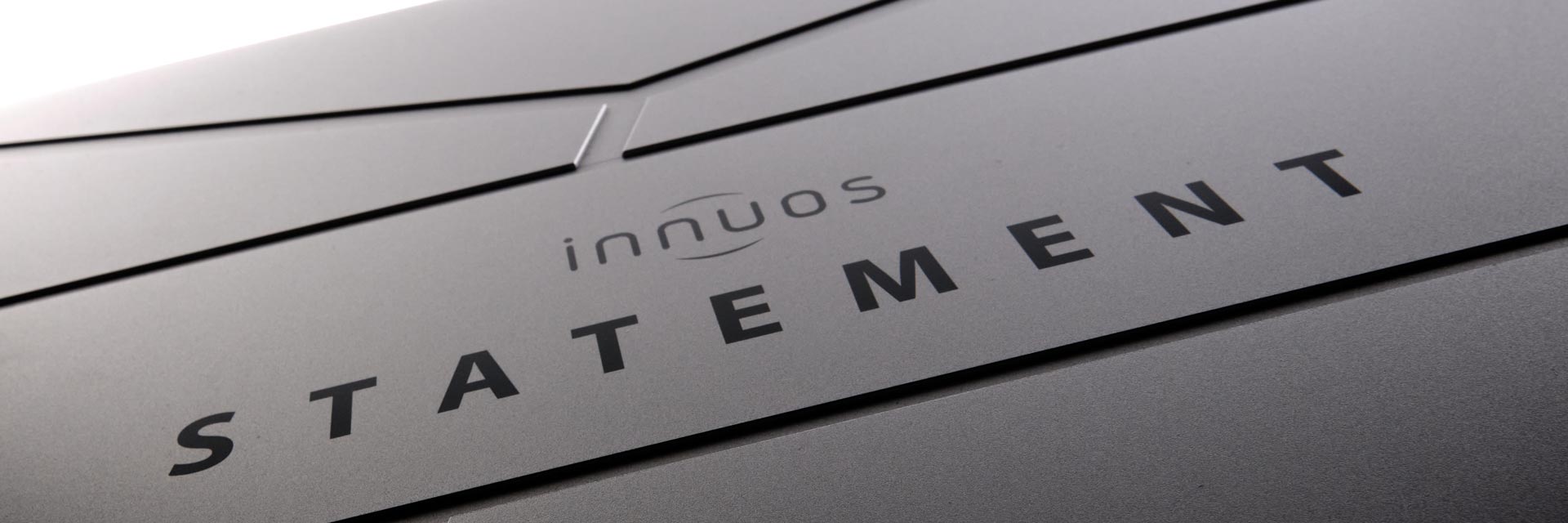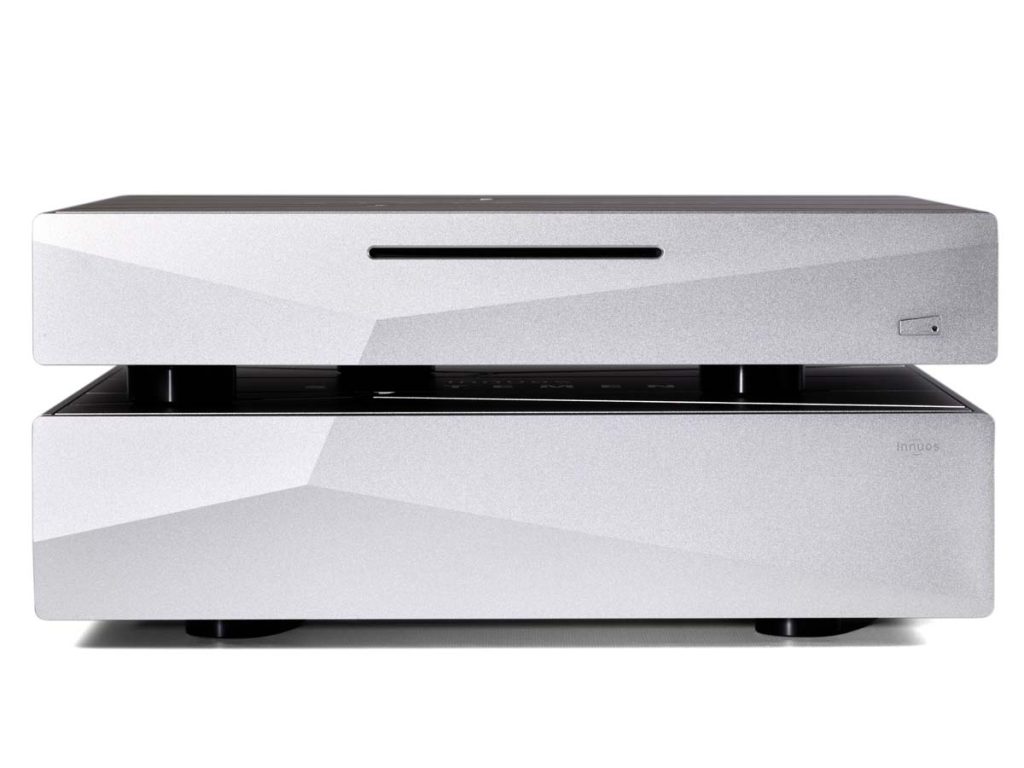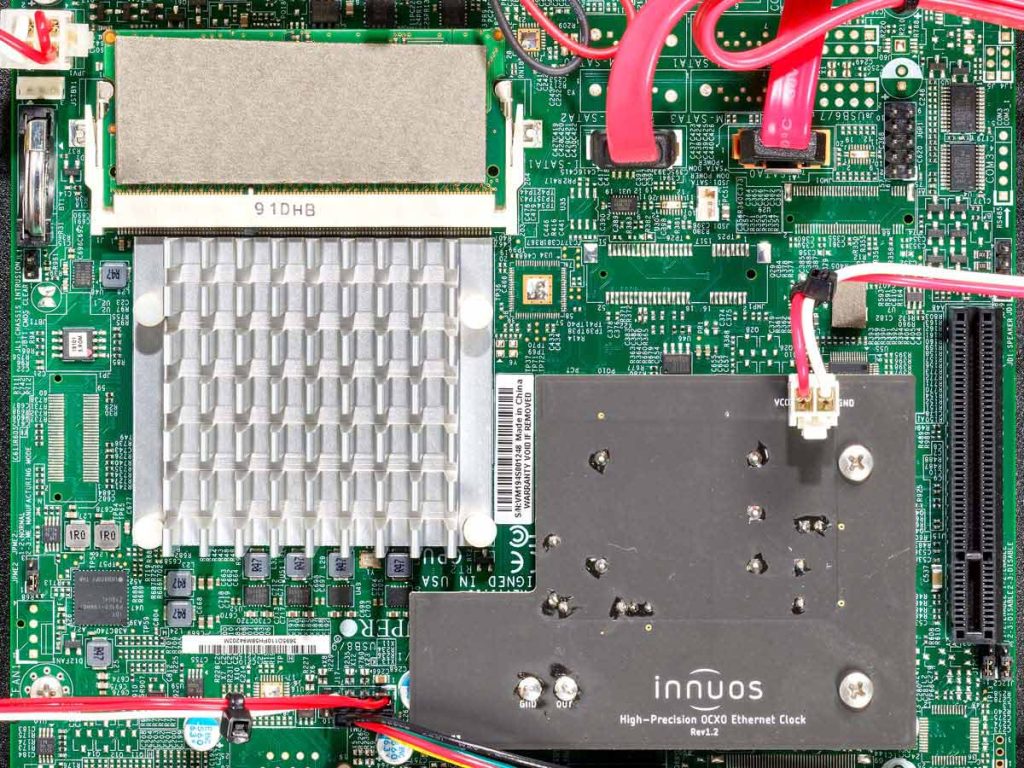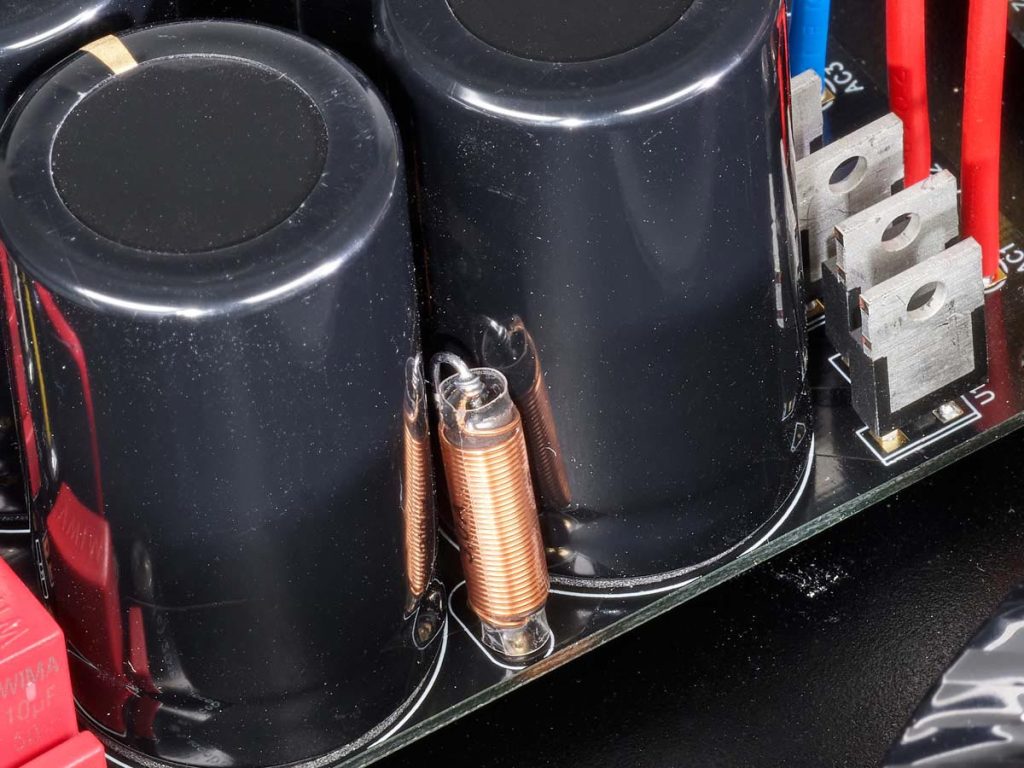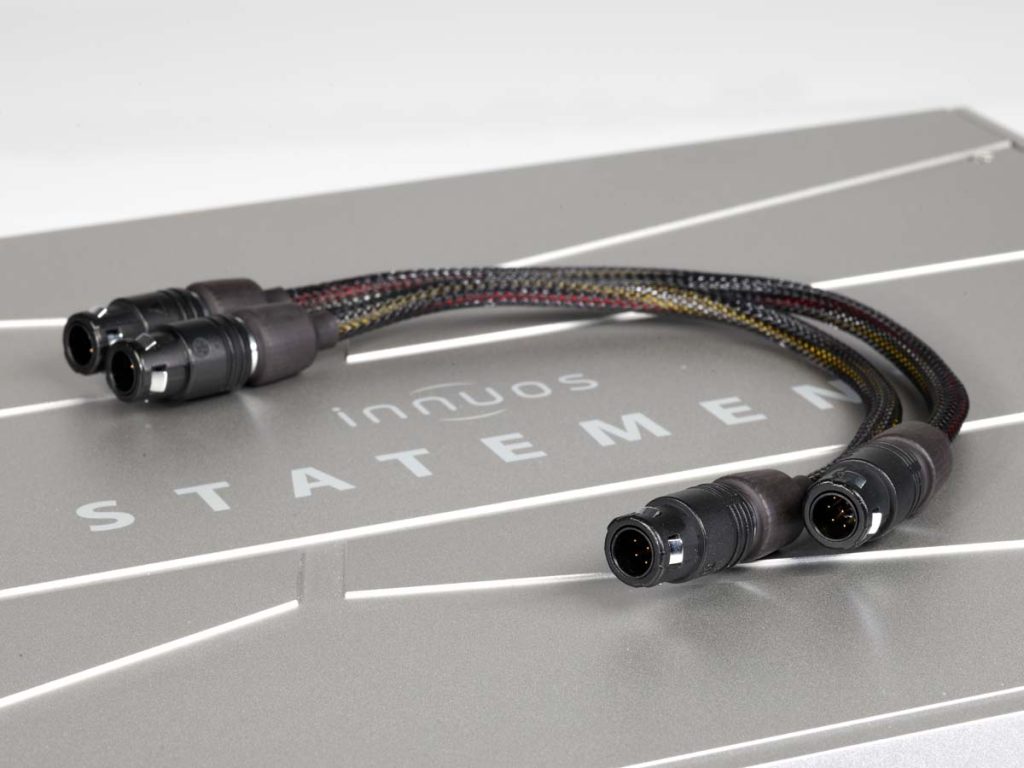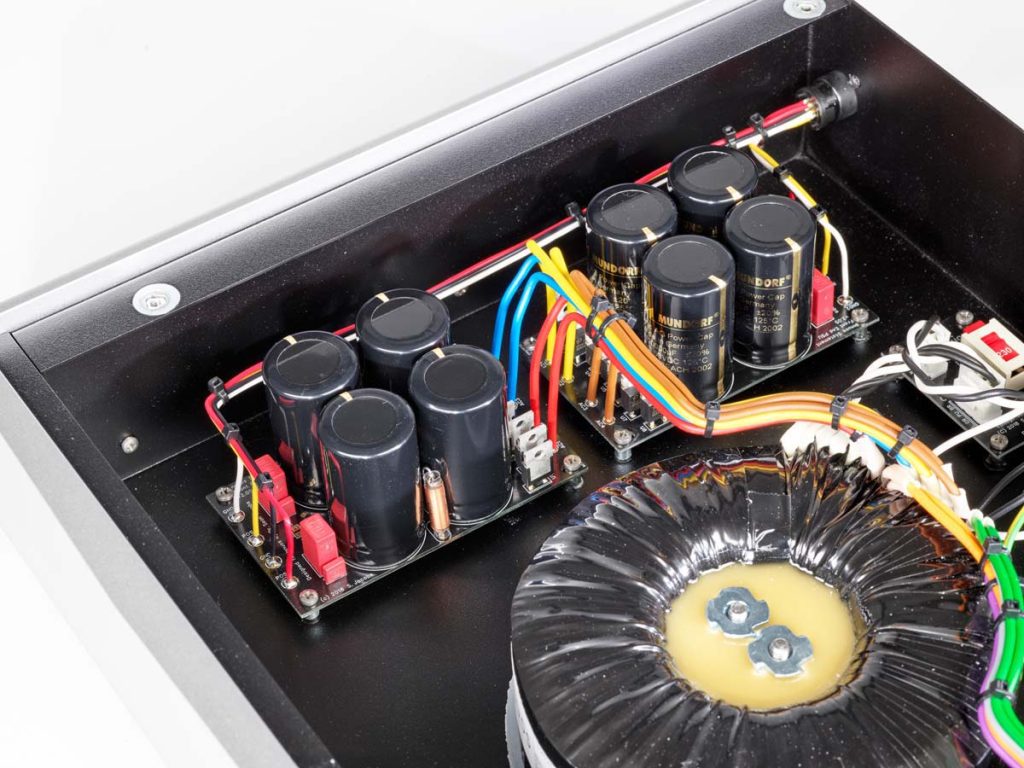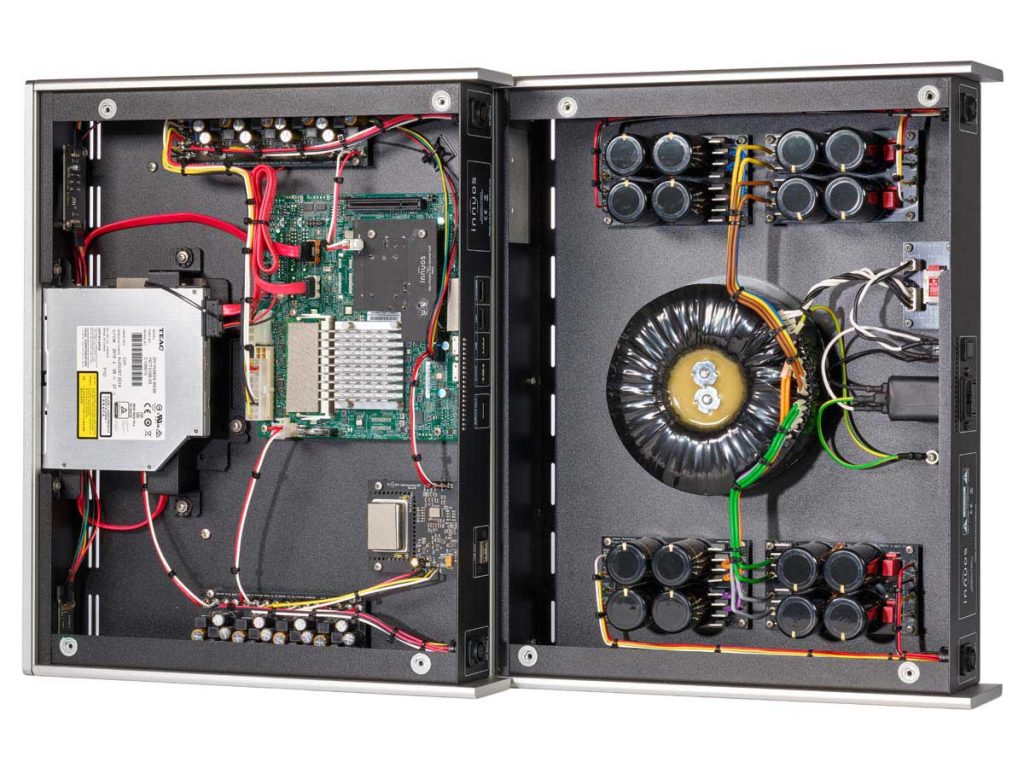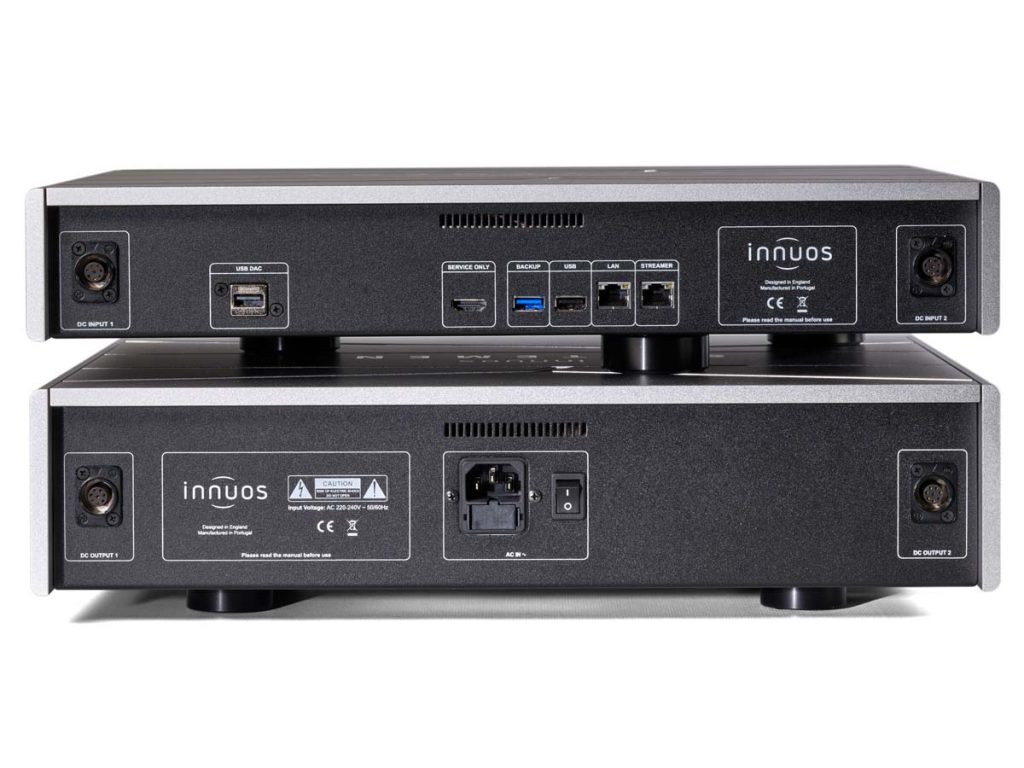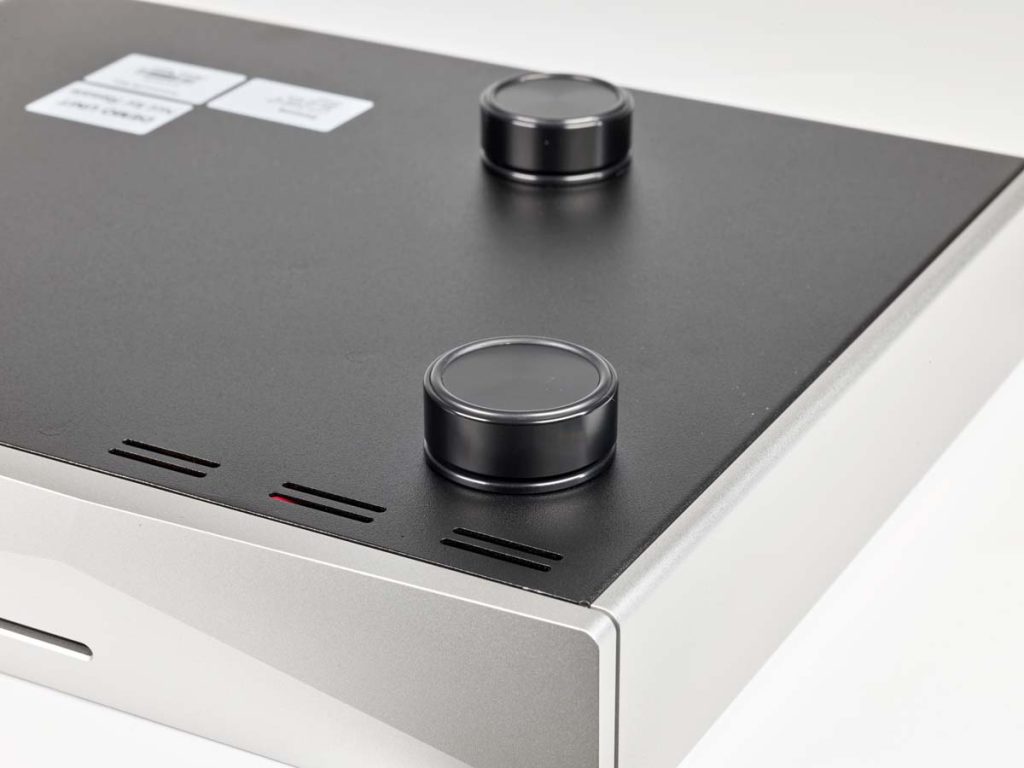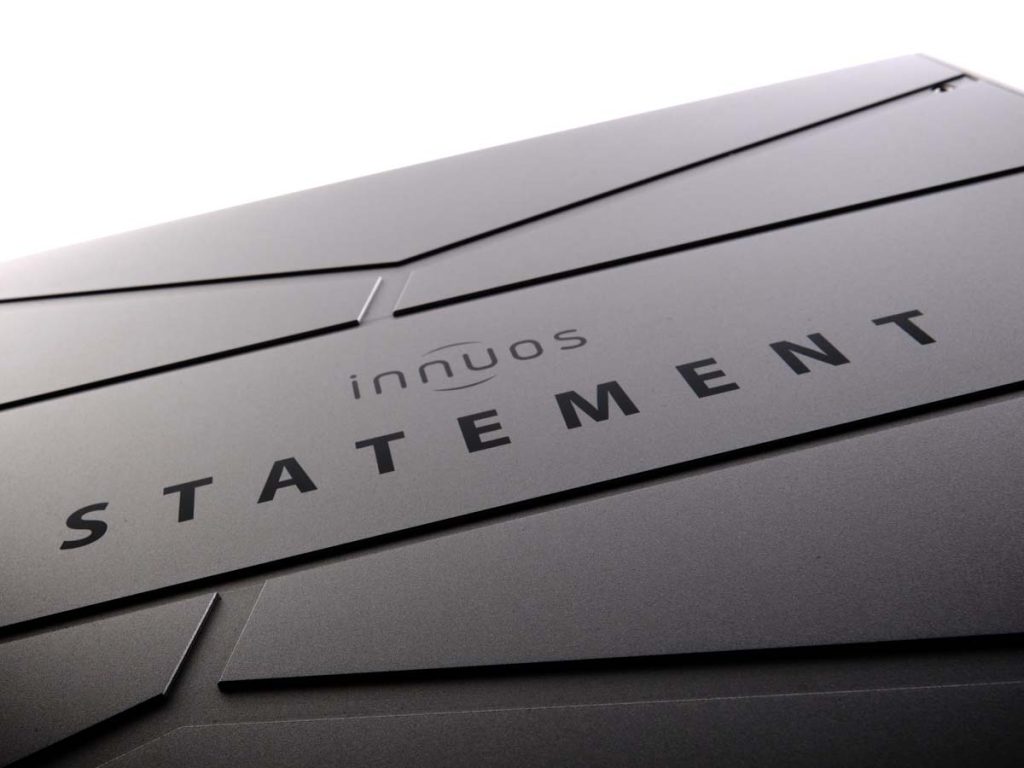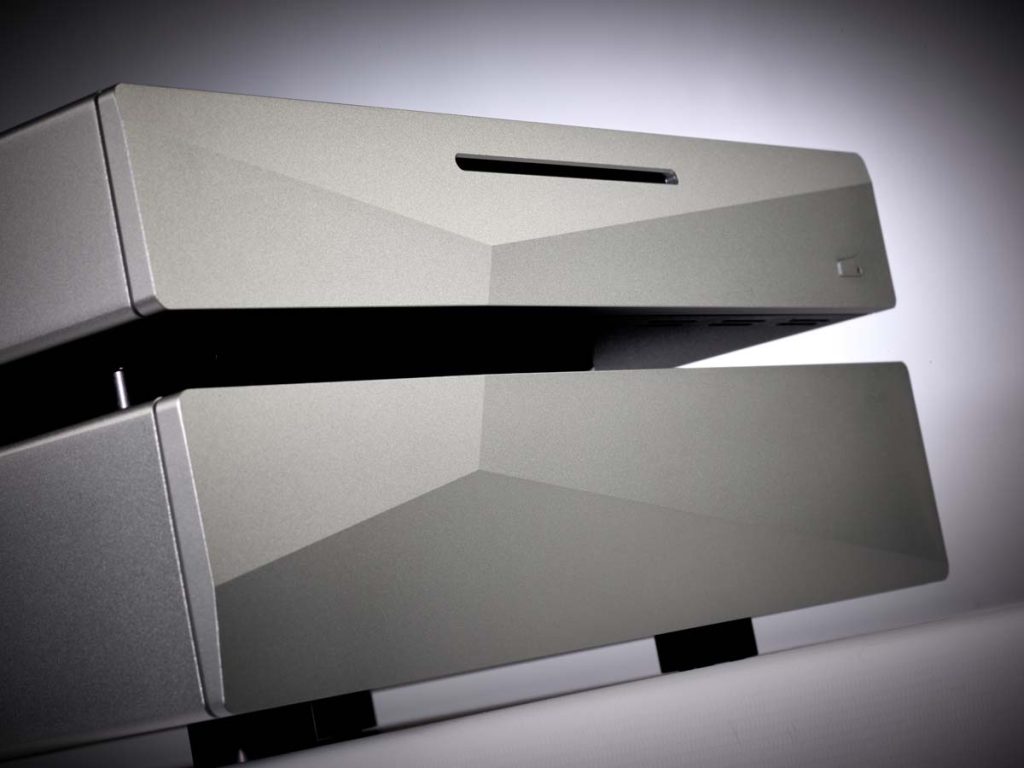“Innuos Statement” sounds like an extremely promising name. And when put to the test, this hefty server not only proved it’s worthy of such a name, it also surprised us with some of the innovative and logical approaches taken in its design. A musical tour de force with an unusual source setup.
Tsssst — and with a soft purring sound, the first CD disappeared into the server’s designated slot. Just a few minutes earlier, I had found myself downstairs in the cellar rummaging through various moving boxes, frantically trying to put together a representative pile of optical media. I hadn’t seen sight nor sound of any physical vinyls or discs for years with the exception of a modest yet select record collection. I looked at the iPad for a second and wondered why the display wasn’t giving me any feedback or asking me what the drive should start doing with the shiny disc. I was at the point of wanting to dive deep into the device’s setup structures when I picked up some quiet but familiar sounds… the ripper was starting without any input from me. A few minutes later, I heard another “tsssst” as the Innuos Statement spat out the CD, which was still warm to the touch.
I repeated the process around 20 times, a task that, to my surprise, took scarcely two hours. Still, I didn’t detect so much as a whiff of superficiality or flippancy about the whole thing. The Statement can even handle discs that have taken a real battering. For just such occasions, I always keep a handful of discs on hand that have had a chance to “mature” over the years in various car CD changers. Countless such devices have thrown in the towel when confronted with such a bruised and battered pile — and who could really blame them? The Innuos, on the other hand, took its time and read these discs, too, without uttering any complaints at all, although I didn’t have too many high hopes for the results. After all, it’s not a magician.
“We had plenty of opportunities to optimize our software,” explained the colossal device’s creator, Nuno Vitorino, the next day during a telephone interview in which I fired off questions while sitting in the Ismaning, Germany, editorial team’s office and he answered from the comfort of his office at home in Portugal. The Statement’s intelligence and routine processes are deeply rooted in the custom-made “innuOS” operating system, which the manufacturer has been refining, polishing, and improving ever since the company was founded back in 2009. Once the server has recognized a medium, it consults a whole range of prespecified online databases, browses through FreeDB, MusicBrainz, Discogs, and GD 3 looking for identical, contradictory, or additional meta tags before then making all the decisions itself. It has an impressive success rate, I later found out. The tags both matched and were detailed. Only the genres involved a bit of tweaking here and there — but, hey, we each have our own ideas and opinions when it comes to that topic. After all the tags had been found (in a matter of just a few seconds), the server started the ripping process without losing a beat, stripped the binary data from the optical medium at the perfect speed, converted the bit-perfect PCM signal into the desired audio format, and stored the lossless copy of the CD in its SSD memory.
The basic version of the music computer boasts 1 terabyte, which is sufficient for around 2,000 uncompressed (WAV or AIFF) albums. In FLAC format, which was preset for our test device, you can save an additional 30% to 40% of memory space, allowing you to store the content of up to 2,800 CDs. But if that’s still not enough, fear not! The manufacturer’s flagship model boasts up to 4 terabytes — and even that amount of storage capacity can be expanded in various ways. I have previous experience with the highly respected TEAC drive and even own some external USB versions. It’s known for being solid, durable, and extremely accurate. The version in the Statement is not, however, the standard model, but rather the industry-grade spin-off version issued to OEM partners. This drive was even a little more feisty, Vitorino informed me and, most especially, so readily available that, if necessary, it could still be replaced even years down the line. At the end of the optical era, this is nothing to scoff at. The drive is also a shining example of the server’s many well-thought-out details.
But before we take a deep dive into other intricate details, I have something to confess: I was rather pleased with the sound quality achieved from my ripping experiments. I have around 6,500 CDs stored in my cellar, which, over several sittings, I’ve copied to hard drives using various drives and programs and now comprise my primary source for music. They involve several years of blood, sweat, and tears that I’d be reluctant to repeat if it turned out the Statement would be an altogether superior beast. And, of course, my fears were confirmed: Later while listening and comparing tracks, I had to admit that the Statement works brilliantly and really lives up to its name in terms of reading discs and archiving tracks. The sound came across slightly more vivid and transparent than with my own hard drive and seemed more composed. I was, however, saved the dilemma of considering the launch of a new all-out ripping attack as the server’s main strength actually lies elsewhere:
While the Statement was still busy reading my CDs, I discovered an entry in the remote interface for supported web services — the server’s streaming bridge boasts internet radio, Tidal, Qobuz, and Spotify playback. I quickly entered my Tidal account details and launched a random list using a second app, which I’ll explain in more detail later. As luck or fate would have it, I not only ended up with a perfect description for my first impression of listening to the device but also got a fantastic headline for this article: The first song the Innuos server graced my ears with was Depeche Mode’s “Never Let Me Down Again” from their album Music For The Masses. The resonant guitar compressed beyond all recognition that features in the track’s intro conveyed such a phenomenal impression of depth, managed to fill the room so well, and sounded so engaging that I was left speechless.
I pressed “Play” again to relisten to those precious two or three seconds I just described. Anyone who knows that track will be able to imagine how direct, vivid, and amazing the hammering kick drum, the lashing snare drum, and the fanfare-like sampler sound that immediately follows came across. The music was expressed so naturally and freely in the room — as if no speakers or system were involved. Shortly after, I also activated Qobuz and bathed in the sounds from the high-resolution version of the first Black Sabbath album. Although musically speaking it might not be to everyone’s taste, the Brits’ debut album is, for me, one of the best-produced rock albums of all time. The guitars featured in the epic final track “Warning” brushed against my ears from left and right yet seemed to emanate from outside the room, while Mr. Osbourne, sounding super focused and crystal clear, stood front and center stage. If I’ve ever, in any of my tests, incorrectly asserted that, from a sound-quality perspective, online streaming is in any way inferior to physical media, then I hereby revoke that statement with three exclamation points: !!! I have never heard Qobuz or Tidal sound so fascinating, natural, or thrilling.
Innuos Statement – The Hard Hardware
“Bingo!” exclaimed Vitorino, congratulating me as I told him about my experience. He confirmed I had done exactly the right thing by starting off with an online streaming service as it was the only way to discover all the great features the hardware has to offer. Let’s look at this in more detail:
The Statement is divided into two housing units, which prompted me to pose a specific question right at the start of our interview: The standard connection cables supplied with the device are very short, so I wanted to know if longer versions were available that would allow me to place the components on separate levels of my rack. “Yes, they’re available, and they can be ordered. But please don’t!” he responded, a surprising sense of urgency in his voice. Apparently, the housing units have been specifically designed and harmonized so their thick front panels would feature a complementary line. One should therefore be placed directly on top of the other in order to achieve the desired visual effect. What’s more, the fact they’ve been split in two has absolutely nothing to do with vibrations so you can safely cast aside any audiophile concerns. The aluminum walls of both device chassis are 10 millimeters thick with asymmetric isolation feet also helping. This brings the total weight of the Statement to a solid 22 kilos. Absolutely nothing’s going to rattle, vibrate, or resonate there — guaranteed! The bottom and decidedly heavier device contains eight separate transformers, which remain deliberately unfiltered. The power is transferred over the aforementioned cables into the server’s main unit. Here’s where you’ll find eight filtered power rails located on (or, better still, “in”) the components they feed. With this approach, the comparatively low active currents no longer have to cover any distance, which, in turn, reduces any susceptibility to interference. The motherboard alone has four supply cables. The other components that benefit include the USB output, the SSD hard drive, and the reclockers for both the USB controller and Ethernet controller.
This design aims to not just achieve clean, discrete power, but, above all, “the suppression of EMI” (electromagnetic interference); and thanks to the design, the hefty transformers do not disturb the more sensitive signal-processing components. And even more crucially, the high-frequency (HF) noise from the built-in computer doesn’t negatively impact the transformers as the filters also work in the opposite direction. Vitorino doesn’t think much of separately enclosing individual components, which he says confines HF noise within the components to a certain degree. He prefers to prevent dispersion from the outset. In a bid to minimize HF noise, Innuos has its own small-batch series of motherboards manufactured, which must cost a fortune. They’ve been slimmed down and pared back wherever possible and what’s left is a powerful Intel quad-core CPU (N4200) with corresponding (8-gigabyte) RAM as well as a network controller and a USB controller. And that’s precisely where the hardware’s next impressive feature can be found: Both controllers have been additionally fitted with ultra-precise OCXO clocks (by separately enclosing temperature-stabilized crystals) that reclock the Statement’s LAN input, USB line tap, and signals as well as clean up any jitter and interference. In the case of online streaming, both reclockers work on the signal, first at the LAN input and in the end at the USB output, which was usually connected with Auralic’s Aries G2 during my testing.
In addition to its Ethernet port, the Statement also possesses two main line taps for audio components: One (LAN) is reserved for a streamer that’s addressed over a built-in mini-switch expressly for that purpose. This ensures the home WLAN router doesn’t get in the way of the signal path, and the other (USB) can communicate directly with DACs. The Statement accepts “class-compliant” devices and should therefore work seamlessly with most DACs. The server can certainly supply data over its LAN input to other streamers dispersed throughout the network — and achieve excellent quality, too. In addition to UPnP and DLNA, the server also supports Sonos’s ever-popular Multi-Room protocol. Additional USB ports are provided for memory expansions. They accept every type of hard drive with any amount of capacity. A particularly fast USB 3 port is also provided for backups, also making the server state of the art in terms of the logical separation and allocation of its connections.
System operation
The manufacturer splits control of its innuOS in two. The first half is located directly within the Statement itself. If you type “my.innuos.com” into any web browser, you’ll be taken straight into the clearly laid out tabular back end. This is exceedingly practical as it allows you to configure your sometimes complex settings on a computer’s large monitor. The web interface is fundamentally responsible for the basic settings: What audio format should be used for ripping tracks? Which streaming services should be activated and displayed? In fact, you can also view information about the remaining memory you have or define external NAS and USB hard drives as backup media or register them as additional capacity. Conversely, you can import existing music collections from USB or LAN storage media. And, lastly, the server also has a library view (without playback function) where you can check meta tags and, if necessary, edit them then and there. The USB latency setting — which can be used to achieve subtle, yet sometimes audible, differences in the interplay between server and DAC — deserves special mention here: Usually, the preset short latency is perfect, but longer buffering can sound softer, smoother, and more velvety depending on the converter. A bit of trial and error is needed here, but it works and is really worth it as the Statement immediately adopts any changes you make.
Playback is controlled using third-party apps. Innuos recommends Orange Squeeze (Android), Squeeze Control (Windows), or iPeng 9 (iOS), which we used. Insiders will immediately spot that the manufacturer has drawn from Logitech’s Squeezebox concept as a basis. It’s an excellent choice as this interface was considerably faster and more fluid than the extremely open UPnP standard. As expected, the app proved to be reliable and crash-proof, and it responded unbelievably quickly in conjunction with the Statement. Admittedly, getting the hang of controlling such a complex server takes a bit of time at first — after all, it can rip CDs, stream online music, play Internet radio, and play media from the SSD. And, in addition to all that, it also boasts the Multi-Room function. Something we found helpful in this regard, however, was the fact the iPeng 9 interface is freely configurable. The inputs and functions can be arranged any way you’d like. In the meantime, Innuos is currently planning to release its own remote app across all platforms in the next few months, these apps will cover everything (setup and playback). Alternatively, the Statement is actually already Roon Ready. It can be used as the Roon Core (the thinking nerve center of a Roon network) or serve other cores as a data source to produce an attractive sound.
Which audio formats can it handle? Basically, it understands the well-established codes, most notably, of course, FLAC, Apple Lossless, MP3, AAC, WAV, and AIFF. Its resolution capability ranges from 16 to 32 bit, and the sample rate can extend from 44.1 to 384 kilohertz. The high-bit format MQA as well as DSD are real treats. The Statement either natively passes the SACD format on to capable converters or ties it up in DoP packages (DSD over PCM). No conversion takes place in the process, as is often incorrectly assumed. The USB inputs of many DACs are simply unable to process the continuous 1-bit streams. To address this, the server packs the DSD stream into bite-sized 16-bit packages. The USB port thinks they are WAV or FLAC and passes them on to the converter, which unpacks the packages and plays them losslessly.
Conclusion
Ultimately, the most important question is who Innuos plans to target with its server. Just looking at the raw data, facts, and figures, I would have said a few weeks ago that the Statement is presumably an excellent ripping server boasting impressive craftsmanship and a smooth and supple design — precisely the right device for supplying a high-end chain with data at the right level and for covering all (and I really mean all) aspects of media management. In that assumption, I would have essentially been correct. And yet I now feel as though that definition is anachronistic and on the verge of insulting.
Don’t get me wrong: The Statement can meet all the aforementioned demands perfectly and it’s even an exceptional, meticulously bit-precise CD ripper. Its focus is not, however, just on handling “media from yesteryear,” but in fact lies even more squarely on the future: Its two reclockers, the playback buffer memory of a rather fabulous 4 gigabytes, and the exceptionally pure signal currents that never get in each other’s way are primarily designed to ensure optimum-quality web data source playback. The target audience is, of course, primarily Qobuz and Tidal users — and we’ve never heard these services sound so polished or sophisticated.
And the hefty heavyweight lives up to its name in other ways, too: Innuos designed the superb operating system as an open interface, which means the manufacturer can respond quickly and flexibly to future changes and upgrade the design as well as remove any outdated or unwanted dead weight. This leads me to feel confident (which is very rarely the case with such systems) that the computer will still serve as an outstanding and reliable partner for all facets of digital playback, even many years down the line. And now I’m afraid you’ll have to excuse me … I want to get back to listening!
Accompanying equipment
Sources: T+A MP1000E, Audiodata MS II, Melco N1A, Auralic Altair, and Aries G2 | Amplifiers: Naim Uniti Nova, Trigon Exxceed | Rack: Creaktiv Midi Reference, Solidsteel Hyperspike | Cables: AudioQuest, Chord Company, Wire World
Music server
Innuos Statement
Concept: Ripping-capable UPnP music server with integrated streaming bridge | Connections: 2 x LAN (one reserved for streamer), 2 x USB 2 (one reserved for DACs), 1 x USB 3 for backup media | CD ripper: TEAC drive, reads CDs, CD-Rs, and CD-RWs; encodes data as WAV or FLAC | Meta data: FreeDB, Music-Brainz, Discogs, and GD3 | Online streaming: Qobuz, Spotify Connect, Tidal, and Internet radio | Formats supported for playing: WAV, AIFF, FLAC, ALAC, AAC, MP3, MQA, and DSD; 16 to 32 bit; 44.1 to 384 kHz | Hardware: Intel CPU (N4200 quad core), 8 GB RAM (4 GB reserved for playback buffer), custom-made motherboard, external power supply, internal SSD memory with 1 to 4 TB | Control: Web interface (only basic settings and tag editor), app for Android, iOS and Windows, Roon Ready, Sonos Multi-Room compatible | Power consumption: between 20 and 35 W | Dimensions (W/H/D): 42/11/35 cm (power-supply unit), 42/9/35 cm (server) | Weight: 22 kg (total) | Warranty period: two years | Price: about €11,000 (1 TB), about€11,500 (2 TB), about €12,100 (4 TB)
Innuos, The Venture Centre
University of Warwick Science Park, Sir Williams Lyons Road
Coventry, England CV4 7EZ
Phone: +49 800 724 4538

